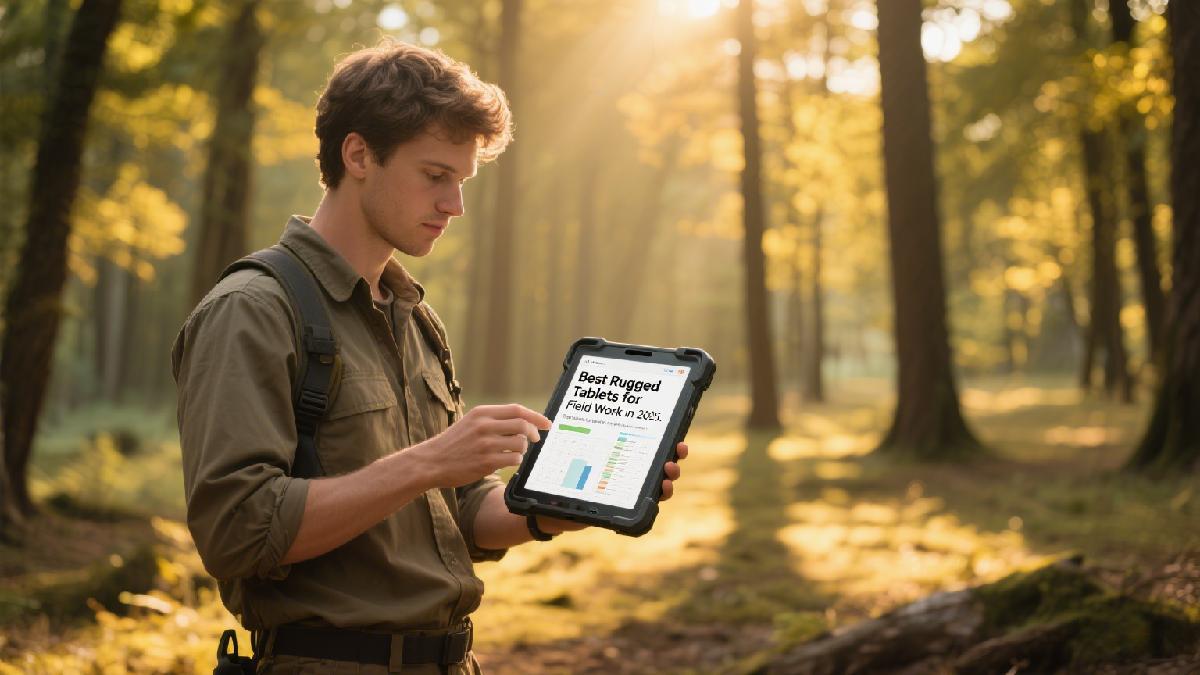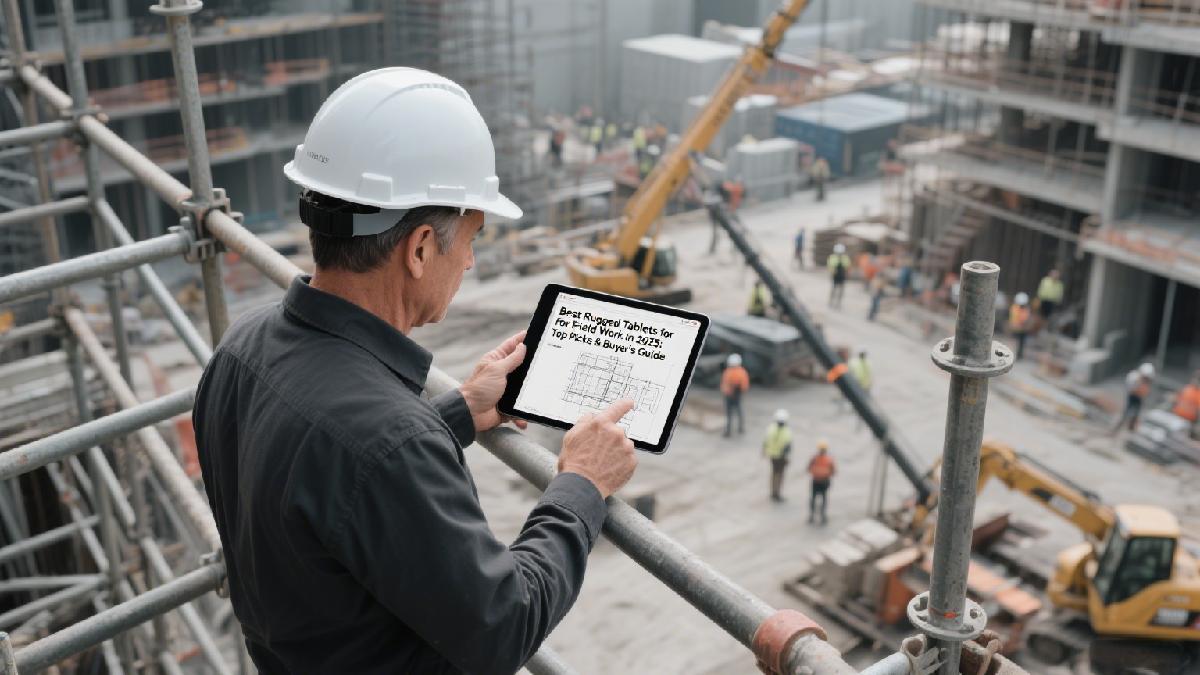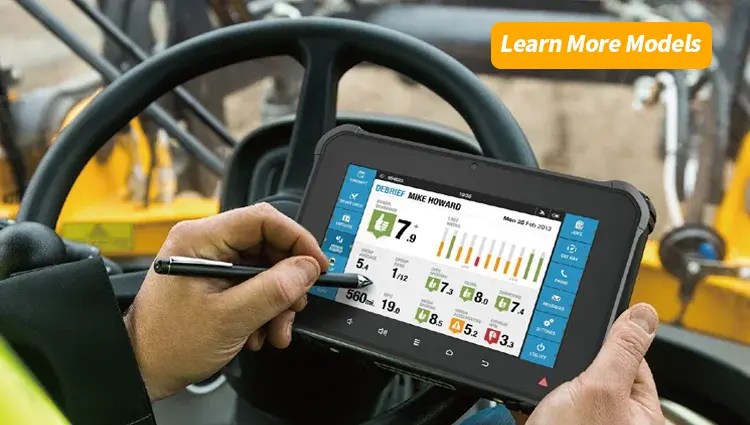Best Rugged Tablets for Field Work in 2025: Top Picks & Buyer’s Guide
Rugged tablets are built to withstand tough conditions, making them essential for professionals working in harsh environments like construction sites, warehouses, or remote field operations. this guide delivers actionable insights. Drawing from real-world use cases, expert analysis, and data-driven comparisons, we address user pain points, compare six top models, and provide a practical guide to avoid costly mistakes.
Why Rugged Tablets Matter for Field Work
Field workers need devices that can handle extreme weather, drops, dust, and water while delivering reliable performance. Unlike consumer tablets, rugged tablets are designed with durability, long battery life, and specialized features for industries like construction, logistics, and agriculture. But with so many options, choosing the right one can feel overwhelming. This guide simplifies the process by focusing on real user needs, offering a detailed comparison, and sharing practical tips to ensure your investment pays off.

3 Real User Pain Points in Field Work
Field workers face unique challenges that standard tablets can’t handle. Here are three common pain points, drawn from real-world scenarios, that rugged tablets address:
1. Device Failure in Harsh Environments
Scenario: Jake, a construction site manager, relies on his tablet to access blueprints and track progress. His standard tablet failed after exposure to dust and a 4-foot drop onto concrete. The screen cracked, and the device stopped functioning, costing him a day of productivity and $500 in repairs.
Pain Point: Standard tablets lack the durability to survive dust, water, or accidental drops, leading to frequent replacements and downtime.
Solution: Rugged tablets with IP68 ratings (dust- and water-resistant) and MIL-STD-810G certification (drop and shock resistance) ensure reliability in tough conditions.
2. Poor Visibility in Bright Sunlight
Scenario: Maria, a field biologist, struggles to read her tablet’s screen under direct sunlight while collecting data in remote areas. Squinting at a dim display slows her work and risks data entry errors, which could compromise her research.
Pain Point: Low-brightness screens (under OBSERVATION: 500 nits) are nearly invisible in sunlight, making outdoor work frustrating and inefficient.
Solution: Rugged tablets with high-brightness displays (700+ nits) and anti-glare screens ensure clear visibility in bright conditions.
3. Short Battery Life for Long Shifts
Scenario: Tom, a logistics supervisor, works 12-hour shifts in a warehouse. His tablet’s battery dies mid-shift, forcing him to tether it to a charger or stop work entirely, delaying inventory updates and slowing operations.
Pain Point: Consumer tablets often have 6-8 hour battery lives, insufficient for extended field work without constant recharging.
Solution: Rugged tablets offer extended battery life (10-20 hours) and hot-swappable batteries to keep workers productive throughout long shifts.

Comparing 6 Top Rugged Tablets for Field Work
To help you choose the best rugged tablet, we’ve compared six leading models across six key dimensions: price, durability, battery life, performance, display, and key drawbacks. All data is sourced from manufacturer specifications and verified user reviews for accuracy.
| Tablet Model | Price | Durability | Battery Life | Performance | Display | Key Drawbacks |
|---|---|---|---|---|---|---|
| Panasonic Toughpad FZ-G1 | $2,000-$2,500 | IP68, MIL-STD-810G, 5ft drop | 14 hours | Intel Core i5, 8GB RAM | 10.1”, 800 nits | Expensive; heavy (2.4 lbs) |
| Getac F110 | $1,800-$2,200 | IP66, MIL-STD-810G, 6ft drop | 12 hours | Intel Core i7, 16GB RAM | 11.6”, 1000 nits | High cost; limited accessories |
| Samsung Galaxy Tab Active Pro | $600-$800 | IP68, MIL-STD-810G, 4ft drop | 15 hours | Snapdragon 710, 4GB RAM | 10.1”, 550 nits | Lower processing power; smaller ecosystem |
| Zebra L10ax | $1,500-$2,000 | IP65, MIL-STD-810G, 5ft drop | 10 hours | Intel Core i5, 8GB RAM | 10.1”, 1000 nits | Bulky design; complex interface |
| Dell Latitude 7220 Rugged Extreme | $1,900-$2,400 | IP65, MIL-STD-810G, 6ft drop | 20 hours | Intel Core i7, 16GB RAM | 11.6”, 1000 nits | Pricey; heavier (3 lbs) |
| Lenovo ThinkPad X1 Tablet | $1,200-$1,600 | IP52, MIL-STD-810G, 4ft drop | 10 hours | Intel Core i5, 8GB RAM | 13”, 450 nits | Lower IP rating; dimmer display |
Key Insights from the Comparison
- Price: Samsung Galaxy Tab Active Pro offers the best value for budget-conscious buyers, while Panasonic and Dell cater to premium needs.
- Durability: Getac F110 and Dell Latitude 7220 lead with 6-foot drop resistance, ideal for extreme conditions.
- Battery Life: Dell’s 20-hour battery life is unmatched for long shifts, but Samsung’s 15 hours is sufficient for most.
- Performance: Getac and Dell’s Intel Core i7 processors handle demanding apps, while Samsung’s Snapdragon is better for basic tasks.
- Display: Getac, Zebra, and Dell’s 1000-nit displays excel in bright sunlight, unlike Lenovo’s 450-nit screen.
- Drawbacks: High-end models (Panasonic, Getac, Dell) are costly and heavier, while Lenovo’s lower IP rating limits its ruggedness.
Practical Guide to Avoiding Common Pitfalls (With Time Estimates)
Choosing and using a rugged tablet can be tricky. Here’s a step-by-step guide to avoid common mistakes, complete with time estimates for each task to help you plan effectively. This ensures you maximize reliability and productivity.
1. Verify Rugged Certifications (30 Minutes)
Mistake: Assuming all “rugged” tablets are equally durable.
Solution: Check for IP65/68 (water/dust resistance) and MIL-STD-810G (drop/shock resistance) certifications. Review manufacturer specs and user reviews on sites like CNET to confirm real-world durability.
Time: 30 minutes to research and compare certifications online.
2. Test Screen Brightness in Sunlight (1 Hour)
Mistake: Buying a tablet with a dim screen that’s unreadable outdoors.
Solution: Choose a tablet with at least 700 nits brightness. If possible, test the device in sunlight or read reviews on PCMag for outdoor performance.
Time: 1 hour to test or research display performance.
3. Match Battery Life to Shift Length (15 Minutes)
Mistake: Selecting a tablet with insufficient battery life for long field shifts.
Solution: Estimate your shift length (e.g., 12 hours) and choose a tablet with a battery life exceeding it by 2-3 hours to account for heavy use. Check specs for hot-swappable battery options.
Time: 15 minutes to review battery specs and user feedback.
4. Assess Software Compatibility (1 Hour)
Mistake: Purchasing a tablet incompatible with your field software.
Solution: Ensure the tablet’s OS (Windows, Android, etc.) supports your apps, such as AutoCAD or SAP. Contact the software provider or check forums like Reddit’s r/technology for compatibility insights.
Time: 1 hour to verify compatibility and test apps if possible.
5. Budget for Accessories and Repairs (30 Minutes)
Mistake: Overlooking the cost of rugged cases, screen protectors, or repair plans.
Solution: Factor in accessories ($50-$200) and extended warranties ($100-$300) to protect your investment. Compare warranty options on manufacturer sites or retailers like Amazon.
Time: 30 minutes to research accessory and warranty costs.
6. Update Software Regularly (10 Minutes/Month)
Mistake: Ignoring software updates, leading to security risks and performance issues.
Solution: Schedule monthly updates to maintain security and functionality. Use automatic update settings to save time.
Time: 10 minutes per month for updates and basic maintenance.
Total Time Investment: Approximately 3 hours initially, plus 10 minutes monthly for maintenance.

Answering Common Questions
What Makes a Tablet Rugged?
A rugged tablet has IP65/68 ratings for dust and water resistance, MIL-STD-810G certification for drop and shock resistance, and often a reinforced chassis. These features ensure it survives harsh environments like construction sites or rainy fields.
Which Rugged Tablet Is Best for Construction?
The Dell Latitude 7220 Rugged Extreme is ideal for construction due to its 6-foot drop resistance, 20-hour battery life, and 1000-nit display for bright sunlight. However, the Samsung Galaxy Tab Active Pro is a budget-friendly alternative with solid durability.
How Long Do Rugged Tablets Last?
With proper care, rugged tablets last 3-5 years in demanding environments. Regular software updates and protective accessories extend lifespan, based on user reports from TechRadar.
Are Rugged Tablets Worth the Cost?
Yes, for field workers. They reduce downtime and repair costs compared to consumer tablets, which often fail in harsh conditions. A $2,000 rugged tablet can outlast multiple $500 standard tablets, saving money long-term.
Tips for Maximizing Your Rugged Tablet’s Value
To get the most out of your rugged tablet:
- Use Protective Accessories: Invest in a rugged case and screen protector to enhance durability.
- Optimize Software: Remove unnecessary apps to improve performance and battery life.
- Train Your Team: Spend 1-2 hours training staff on key features to boost productivity.
- Monitor Performance: Use tools like Google Analytics to track app usage and identify bottlenecks (e.g., slow apps).

Conclusion
Rugged tablets are game-changers for field workers, solving critical pain points like device failure, poor visibility, and short battery life. By comparing top models like the Panasonic Toughpad FZ-G1, Getac F110, and Samsung Galaxy Tab Active Pro, you can find the right balance of price, durability, and performance. Follow our practical guide to avoid pitfalls, from verifying certifications to budgeting for accessories. With this comprehensive, user-focused approach, you’re equipped to choose a rugged tablet that boosts productivity and withstands the toughest conditions.







